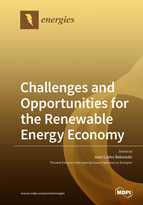Challenges and Opportunities for the Renewable Energy Economy
A special issue of Energies (ISSN 1996-1073). This special issue belongs to the section "C: Energy Economics and Policy".
Deadline for manuscript submissions: closed (31 January 2020) | Viewed by 33232
Special Issue Editor
Interests: financial markets; energy markets; financial econometrics; systemic risk; green finance
Special Issues, Collections and Topics in MDPI journals
Special Issue Information
Dear Colleagues,
Renewable energy deployment as an alternative to traditional energy sources is the cornerstone of the emission-reduction energy policies aimed at facilitating the transition to a low-carbon economy. This transition poses risks and opportunities for companies with business models that rely directly or indirectly on renewables, which will be reflected in the revaluation of assets and in the reallocation of private and public financial investments from carbon-intensive to low-carbon energies. This Special Issue focusses on the current challenges and opportunities for renewable energies, both at the theoretical and empirical level, regarding public policies, financing, competition, trade, technology innovation, market interdependence, and pricing in renewable energy markets. Related topics might be considered so long as they are related to challenges of renewables deployment.
Dr. Juan Carlos Reboredo
Guest Editor
Manuscript Submission Information
Manuscripts should be submitted online at www.mdpi.com by registering and logging in to this website. Once you are registered, click here to go to the submission form. Manuscripts can be submitted until the deadline. All submissions that pass pre-check are peer-reviewed. Accepted papers will be published continuously in the journal (as soon as accepted) and will be listed together on the special issue website. Research articles, review articles as well as short communications are invited. For planned papers, a title and short abstract (about 100 words) can be sent to the Editorial Office for announcement on this website.
Submitted manuscripts should not have been published previously, nor be under consideration for publication elsewhere (except conference proceedings papers). All manuscripts are thoroughly refereed through a single-blind peer-review process. A guide for authors and other relevant information for submission of manuscripts is available on the Instructions for Authors page. Energies is an international peer-reviewed open access semimonthly journal published by MDPI.
Please visit the Instructions for Authors page before submitting a manuscript. The Article Processing Charge (APC) for publication in this open access journal is 2600 CHF (Swiss Francs). Submitted papers should be well formatted and use good English. Authors may use MDPI's English editing service prior to publication or during author revisions.
Keywords
- Renewable energy deployment
- Low-carbon economy
- Current challenges and opportunities
- Renewable energy markets
- Public policies






